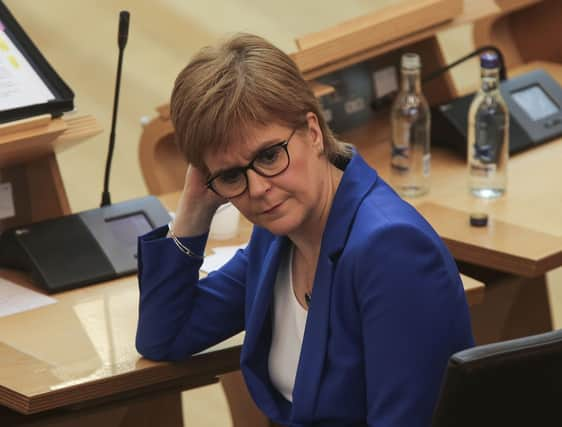Here are the questions Nicola Sturgeon must answer on Covid-19 crisis - Bill Jamieson


Why is it exactly that Scotland merits a “Stay at Home” lockdown response different to that of the rest of the UK?
Why are we being asked to behave differently and remain in lockdown while down south there is now a cautious relaxation and employees are allowed to return to work where possible?
Advertisement
Hide AdAdvertisement
Hide AdSearching questions are being asked as to why First Minister Nicola Sturgeon has insisted on a separate regime.
Many are unclear what the rationale is for the FM’s position. For example, why is the R rate said to be higher in Scotland than in rUK? We are told that the incidence of death in Scotland’s care homes is higher than that in the rest of the UK. But regulation of our care homes is a devolved responsibility.
Did Scotland’s health authorities go along with the policy of discharging elderly patients from hospitals to core homes without checking for symptoms of the disease?
And does such a problem specific to one area of the health and care sector merit the continuation of a general lockdown affecting all parts of the country and the economy?
Until now Westminster policy has been to work with the devolved administrations to ensure a coherent and practical UK-wide response. But a few weeks ago on 23 April it seemed as if First Minister Nicola Sturgeon was in favour of moving towards lockdown relaxation, speaking of a “grown-up conversation” with the Scottish public as she unveiled her government’s plan to lift Scotland’s coronavirus lockdown.
By now Scots were already getting accustomed to separate televised announcements and exhortations from the First Minister, often “front-running” the live daily broadcasts from Downing Street by “the three amigos” – a senior UK government minister flanked by expert statisticians and epidemiologists.
Sturgeon’s remarks, accompanied by a 26-page document, were seen at the time to put pressure on the UK government to spell out its own thinking, as she wanted to “begin to restore some normality to our lives” while keeping the spread of the virus down.
Now there has been what is called a “reverse ferret”. Last week came announcements that the Scottish government, far from leading the way on lockdown relaxation, would be doing the opposite and not following the UK government’s “baby steps” of relaxation. Instead it would retain the “stay at home” exhortation. You may have missed the “grown-up conversation” that preceded this.
Advertisement
Hide AdAdvertisement
Hide AdI certainly did. So what caused the Scottish Government to announce that differences here were now sufficiently material as to justify different advice in Scotland?
Earlier this week Jackson Carlaw, leader of the Scottish Conservatives and until now broadly supportive of Nicola Sturgeon’s response to the pandemic emergency, wrote to the First Minister urging that the reasoning behind her U-turn “is both understood and is transparent”, setting out some of the questions outlined here.
First was a plea for clarity on the ‘R’ number and why, after having stated that the number lay between 0.7 and 1, having fallen from an earlier higher number, the Scottish Government believes progress in reducing it has now stalled?
Why, he asked, does the Scottish Government believe the R number remains higher in Scotland than elsewhere in the UK? “Given that Scotland went into lockdown at an earlier phase in the development of the virus than London, should we not have anticipated that the lockdown measures would have proved relatively more effective?
“Where work has continued, in a safe working environment, what evidence has the Scottish Government made of any spread of the virus eg in schools, which have been open, and other workplaces deemed essential?” And finally, he sought guidance on the likely timetable for Scotland to adopt the cautious steps being progressed elsewhere. The response thus far is that these questions have already been addressed by ministers in various statements.
For now, helped by Barnett consequentials, Scotland remains relatively “shielded” from the financial costs of government measures to soften the economic blow of the pandemic. Taxpayers in England will pay the bulk of the bill – looking at the cost of extending the furlough protection announced this week – reckoned at between £70 billion and £100bn -getting the economy out of a devastating recession needs recognition UK-wide.
That makes it all the more important for the First Minister not to be seen to be exercising powers simply because she can, and to play on small differences to make a political point.
Comments
Want to join the conversation? Please or to comment on this article.